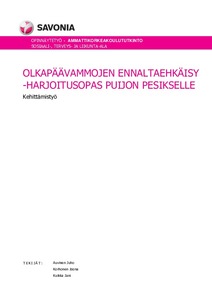Olkapäävammojen ennaltaehkäisy -harjoitusopas Puijon Pesikselle : Kehittämistyö
Auvinen, Juho; Korhonen, Joona; Kuikka, Jani (2020)
Auvinen, Juho
Korhonen, Joona
Kuikka, Jani
2020
All rights reserved. This publication is copyrighted. You may download, display and print it for Your own personal use. Commercial use is prohibited.
Julkaisun pysyvä osoite on
https://urn.fi/URN:NBN:fi:amk-2020120927068
https://urn.fi/URN:NBN:fi:amk-2020120927068
Tiivistelmä
Pesäpallo sisältää lukuisia yläkautta tapahtuvia heittoliikkeitä, jotka kuormittavat olkanivelen rakenteita. Tämän vuoksi koko kineettisen ketjun huomioiminen ja harjoittaminen on tärkeässä roolissa niin vammojen ennaltaehkäisyssä kuin suorituskyvyn parantamisessa. Olkapään ennaltaehkäisevä harjoittelu kuitenkin kohdistuu ensisijaisesti olkaniveltä liikuttavien ja sitä tukevien kudosten vahvistamiseen. Tutkimusten perusteella voidaan todeta, että harjoittelulla on selkeää näyttöä vammojen ennaltaehkäisyssä.
Olkanivel on rakenteellisesti ihmisen liikkuvin nivel, jonka vuoksi se on myös altis rakenteellisille, ikääntymiseen liittyville ja tapaturman jälkeisille muutoksille. Hartiarenkaan toiminta on seurausta glenohumeraali-, acromioclaviculaari-, scapulothoracaali- ja sternoclaviculaarinivelten yhteistoiminnasta. Olkanivelen anatomia rakentuu luiden ja nivelten lisäksi sitä liikuttavista lihaksista, sitä tukevista nivelsiteistä sekä rustorenkaasta (labrum). Olkanivelen toiminnassa on tärkeää myös hyvä sensomotorinen hallinta ja lapaluun optimaalinen toiminta.
Työn tilaajamme on Puijon Pesis ja työn tarkoitus on tehdä harjoitusopas heidän käytettäväksi. Harjoitusoppaan liikkeet on suunniteltu ja valittu nimenomaan ennaltaehkäisyn näkökulmasta. Harjoitteiden ennaltaehkäisevä ja suorituskykyä tukeva vaikutus on tutkimuksin pystytty todistamaan. Opas itsessään koostuu alkulämmittelystä, lihasvoimaharjoittelusta ja loppujäähdyttelyssä. Siinä on tietoa myös olkapään anatomiasta sekä yleisimmistä olkapäävammoista ja niiden syistä. Opas on suunniteltu pesäpalloilijoille ja siitä hyötyvät myös lajin parissa työskentelevät terveydenhuollon ammattilaiset. Pesäpallo features numerous throwing movements from above the head that load the structures of the glenohumeral joint. Therefore, consideration and practice of the entire kinetic chain plays an important role in both injury prevention and performance improvement. However, preventive training of the shoulder focuses primarily on strengthening the tissues that move and support the glenohumeral joint. Studies show that there is clear evidence of training in injury prevetion.
The glenohumeral joint is the most mobile joint in the human body, and due to its large range of mobility it is prone to structural damaging that may be caused by aging and accidents. Motions and mobility of the upper limb is the consequence of glenohumeral-, acromioclavicular-, scapulothoracic- and sternoclavicular joints. In addition to bones and joints, the anatomy of the shoulder joint is made up of the muscles that move it, the ligaments that support it and the cartilage ring (labrum). A good sensomotoric control and optimal scapular function are also important for the glenohumeral joint function.
The client organisation of this thesis was Puijon Pesis, and the aim of this thesis was to make an training guide for their use. The glenohumeral joint is the most mobile joint in the human body, and due to its large range of mobility it is prone to structural damaging that may be caused by aging and accidents. Motions and mobility of the upper limb is the consequence of glenohumeral-, acromioclavicular-, scapulothoracic- and sternoclavicular joints. In addition to bones and joints, the anatomy of the shoulder joint is made up of the muscles that move it, the ligaments that support it and the cartilage ring (labrum). A good sensomotoric control and optimal scapular function are also important for the glenohumeral joint function.
Olkanivel on rakenteellisesti ihmisen liikkuvin nivel, jonka vuoksi se on myös altis rakenteellisille, ikääntymiseen liittyville ja tapaturman jälkeisille muutoksille. Hartiarenkaan toiminta on seurausta glenohumeraali-, acromioclaviculaari-, scapulothoracaali- ja sternoclaviculaarinivelten yhteistoiminnasta. Olkanivelen anatomia rakentuu luiden ja nivelten lisäksi sitä liikuttavista lihaksista, sitä tukevista nivelsiteistä sekä rustorenkaasta (labrum). Olkanivelen toiminnassa on tärkeää myös hyvä sensomotorinen hallinta ja lapaluun optimaalinen toiminta.
Työn tilaajamme on Puijon Pesis ja työn tarkoitus on tehdä harjoitusopas heidän käytettäväksi. Harjoitusoppaan liikkeet on suunniteltu ja valittu nimenomaan ennaltaehkäisyn näkökulmasta. Harjoitteiden ennaltaehkäisevä ja suorituskykyä tukeva vaikutus on tutkimuksin pystytty todistamaan. Opas itsessään koostuu alkulämmittelystä, lihasvoimaharjoittelusta ja loppujäähdyttelyssä. Siinä on tietoa myös olkapään anatomiasta sekä yleisimmistä olkapäävammoista ja niiden syistä. Opas on suunniteltu pesäpalloilijoille ja siitä hyötyvät myös lajin parissa työskentelevät terveydenhuollon ammattilaiset.
The glenohumeral joint is the most mobile joint in the human body, and due to its large range of mobility it is prone to structural damaging that may be caused by aging and accidents. Motions and mobility of the upper limb is the consequence of glenohumeral-, acromioclavicular-, scapulothoracic- and sternoclavicular joints. In addition to bones and joints, the anatomy of the shoulder joint is made up of the muscles that move it, the ligaments that support it and the cartilage ring (labrum). A good sensomotoric control and optimal scapular function are also important for the glenohumeral joint function.
The client organisation of this thesis was Puijon Pesis, and the aim of this thesis was to make an training guide for their use. The glenohumeral joint is the most mobile joint in the human body, and due to its large range of mobility it is prone to structural damaging that may be caused by aging and accidents. Motions and mobility of the upper limb is the consequence of glenohumeral-, acromioclavicular-, scapulothoracic- and sternoclavicular joints. In addition to bones and joints, the anatomy of the shoulder joint is made up of the muscles that move it, the ligaments that support it and the cartilage ring (labrum). A good sensomotoric control and optimal scapular function are also important for the glenohumeral joint function.
